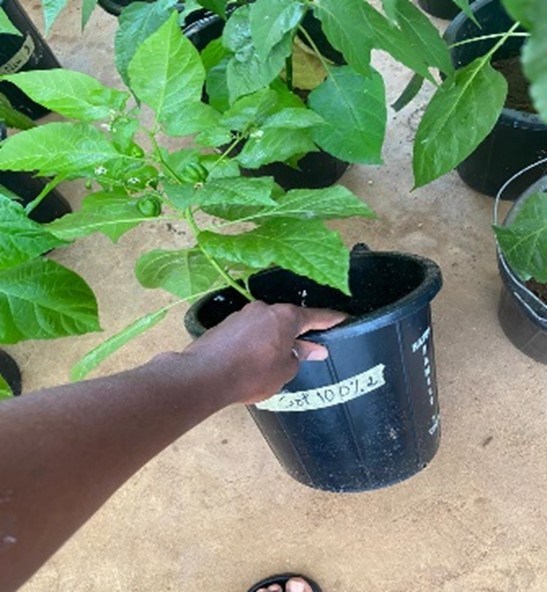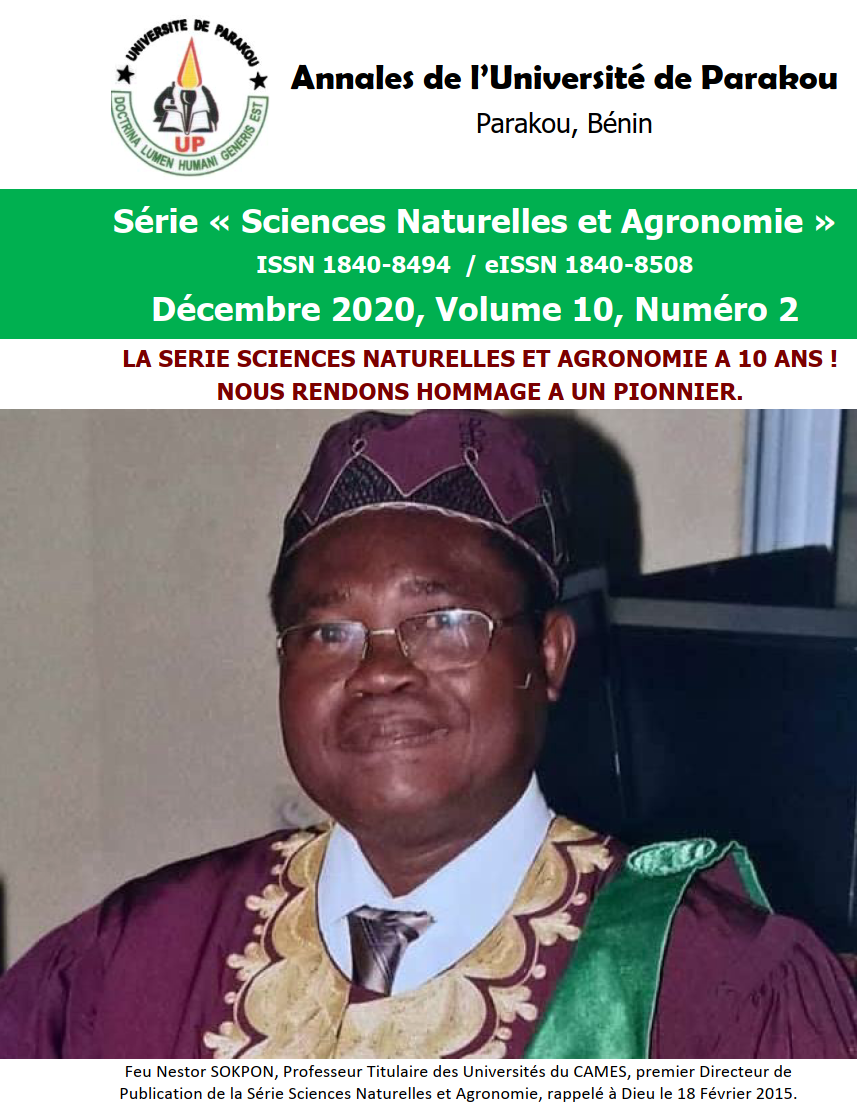Influence of Biochar and Mycotri on the development of nightshade (Solanum macrocarpon L.) and the population density of root-knot nematodes under greenhouse
DOI:
https://doi.org/10.56109/aup-sna.v12i2.106Keywords:
Biochar, nightshade, Mycotri , root-knot nematode, BeninAbstract
In order to reduce the degrading effects of chemical pesticides on the environment and food quality, new alternatives are being sought to control root-knot nematodes in vegetable crops. The present study analyzes the effect of biochar and a formulation (Mycotri) based on fungi and bacteria parasitizing root-knot nematodes in nightshade crops. It was carried out under greenhouse conditions in a complete randomized block design with eight treatments each repeated six times. The different treatments were: biochar (26.6 g/kg sterilized soil), Mycotri (2.6 g/kg sterilized soil) or their combination (40 g biochar and 4 g Mycotri for 1456 g sterilized soil). The results show that biochar, Mycotri and their combination improve soil pH. Biochar and its combination with Mycotri favor the increase of the leaf area of the plants and the mass of the leaves and roots. The gall index, number of galls and nematode population density in the soil were higher in the biochar treatments, while the nematode population density decreased in the roots in the presence of Mycotri. However, the amendment of biochar combined with Mycotri deserves special attention in the control of root-knot nematodes
Downloads
References
Afouda, L., Baimey, H., Bachabi, F.X., Sero-Kpera, D.H. B. R. (2012). Effet de l’hyptis (Hyptis suaveolens), du neem (Azadirachta indica), du vernonia (Vernonia amygdalina), et de l’amarante (Amaranthus Spp.) sur les nématodes à Galles (Meloidogyne spp.) en cultures maraîchères, Agronomie Africaine, 24(3),209–218. https://www.ajol.info/index.php/aga/article/view/87010/76776.
Affokpon, A., Coyne, D. L., Htay, C. C., Agbèdè, R. D., Lawouin, L. & Coosemans, J. (2011). Biocontrol potential of native Trichoderma isolates against root-knot nematodes in West African vegetable production systems. Soil Biology & Biochemistry, 43, 600-608. DOI: https://doi.org/10.1016/j.soilbio.2010.11.029
Alburquerque, J. A., Calero, J. M., Barrón, V., Torrent, J., del Campillo, M. C., Gallardo, A., & Villar, R. (2014). Effects of biochars produced from different feedstocks on soil properties and sunflower growth. Journal of plant nutrition and soil science, 177(1), 16-25. DOI: https://doi.org/10.1002/jpln.201200652
Assogba-Komlan, F., Anihouvi, P., Achigan, E., Sikirou, R., Boko, A., Adje, C., & Ayémou, A. (2007). Pratiques culturales et teneur en éléments anti nutritionnels (nitrates et pesticides) du Solanum macrocarpum au sud du Bénin. African journal of food, agriculture, nutrition and development, 7(4), 1-21. DOI: https://doi.org/10.18697/ajfand.15.IPGRI2-3
Coyne, D. L., Nicol, J. M. & Claudius-Cole, B. (2018). Practical plant nematology: A field and laboratory guide. 3rd edition, International Institute of Tropical Agriculture (IITA), Ibadan, Nigeria, 82p.
Djaouga, N. T., Diogo, R. V. C., Baimey, H., & Godau, T. (2020). Développement du gboma (Solanum macrocarpon L.) sous l’influence du biochar, de la fréquence d’arrosage et des nématodes à galles en conditions de serre. Annales de l’Université de Parakou-Série Sciences Naturelles et Agronomie, 10(1), 33-40. DOI: https://doi.org/10.56109/aup-sna.v10i1.41
Guevara, S. S., & Gomez-Pompa, A. (1972). Seeds from surface soils in a tropical region of Veracruz, Mexico. Journal of the Arnold Arboretum, 53(3), 312-335. DOI: https://doi.org/10.5962/p.185784
James, B., Atcha-Ahowé, C., Godonou, I., Baimey, H., Goergen, G., Sikirou R. & Toko M. 2010. Gestion intégrée des nuisibles en production maraîchère : Guide pour les agents de vulgarisation en Afrique de l’Ouest. Institut International d’Agriculture Tropicale (IITA), Ibadan, Nigeria, 120 p.
Jones, D. L., Murphy, D. V., Khalid, M., Ahmad, W., Edwards-Jones, G., & DeLuca, T. H. (2011). Short-term biochar-induced increase in soil CO2 release is both biotically and abiotically mediated. Soil Biology and Biochemistry, 43(8), 1723-1731. DOI: https://doi.org/10.1016/j.soilbio.2011.04.018
Lehmann, J., Rillig, M. C., Thies, J., Masiello, C. A., Hockaday, W. C., & Crowley, D. (2011). Biochar effects on soil biota–a review. Soil biology and biochemistry, 43(9), 1812-1836. DOI: https://doi.org/10.1016/j.soilbio.2011.04.022
Major, J. (2010). Guidelines on practical aspects of biochar application to field soil in various soil management systems. International Biochar Initiative, 8, 5-7.
Mondédji, A. D. (2010). Potentiel d’utilisation d’extraits de feuilles de neem (Azadirachta indica A. Juss et de Carica papaya L.) dans le contrôle des insectes ravageurs du chou (Brassica oleracea L.) en zones urbaines et périurbaines au sud du Togo. Thèse de doctorat, Université de Lomé, Togo, 193p.
Mukhtar, T., Arshad Hussain, M., & Zameer Kayani, M. (2013). Biocontrol potential of Pasteuria penetrans, Pochonia chlamydosporia, Paecilomyces lilacinus and Trichoderma harzianum against Meloidogyne incognita in okra. Phytopathologia Mediterranea, 66-76.
Oclarit, E., & Cumagun, C. (2009). Evaluation of efficacy of Paecilomyces lilacinus as biological control agent of Meloidogyne incognita attacking tomato. Journal of Plant Protection Research, 49(4), 337-340 DOI: https://doi.org/10.2478/v10045-009-0053-x
Seenivasan, N. (2011). Efficacy of Pseudomonas fluorescens and Paecilomyces lilacinus against Meloidogyne graminicola infecting rice under system of rice intensification. Archives of Phytopathology and Plant Protection, 44(15), 1467-1482. DOI: https://doi.org/10.1080/03235408.2010.505788
Sikora, R. A., & Fernandez, E. (2005). Nematode parasites of vegetables. Plant parasitic nematodes in subtropical and tropical agriculture, (Ed. 2), 319-392. DOI: https://doi.org/10.1079/9780851997278.0319
Steiner, C. (2008). Biochar carbon sequestration. University of Georgia, Biorefining and Carbon Cycling Program, Athens, GA, 30602, USA, 8p.
Tokannou, R., & Quenum, R. (2007). Rapport de l’étude sur le sous-secteur du maraîchage au Sud-Bénin. Rapport provisoire. MAEP, République du Bénin. 25p.
Wang, J., Pan, X., Liu, Y., Zhang, X., & Xiong, Z. (2012). Effects of biochar amendment in two soils on greenhouse gas emissions and crop production. Plant and soil, 360(1), 287-298. DOI: https://doi.org/10.1007/s11104-012-1250-3
Wang, J., Wang, J., Liu, F., & Pan, C. (2010). Enhancing the virulence of Paecilomyces lilacinus against Meloidogyne incognita eggs by overexpression of a serine protease. Biotechnology letters, 32(8), 1159-1166. DOI: https://doi.org/10.1007/s10529-010-0278-9
Xu, G., Wei, L. L., Sun, J. N., Shao, H. B., & Chang, S. X. (2013). What is more important for enhancing nutrient bioavailability with biochar application into a sandy soil: Direct or indirect mechanism? Ecological engineering, 52, 119-124. DOI: https://doi.org/10.1016/j.ecoleng.2012.12.091
Yao, Y., Gao, B., Zhang, M., Inyang, M., & Zimmerman, A. R. (2012). Effect of biochar amendment on sorption and leaching of nitrate, ammonium, and phosphate in a sandy soil. Chemosphere, 89(11), 1467-1471. DOI: https://doi.org/10.1016/j.chemosphere.2012.06.002

Downloads
Published
How to Cite
License
Copyright (c) 2023 Octave BEHOUNDJA-KOTOKO, Fabert SOMAKOU, Nehal Tinon DJAOUGA MAMADOU, Manzidath ALAGBA, Ruffin DOSSOU AGBEDE, Hugues BAIMEY

This work is licensed under a Creative Commons Attribution 4.0 International License.












